1998 PONTIAC BONNEVILLE service
[x] Cancel search: servicePage 2 of 395
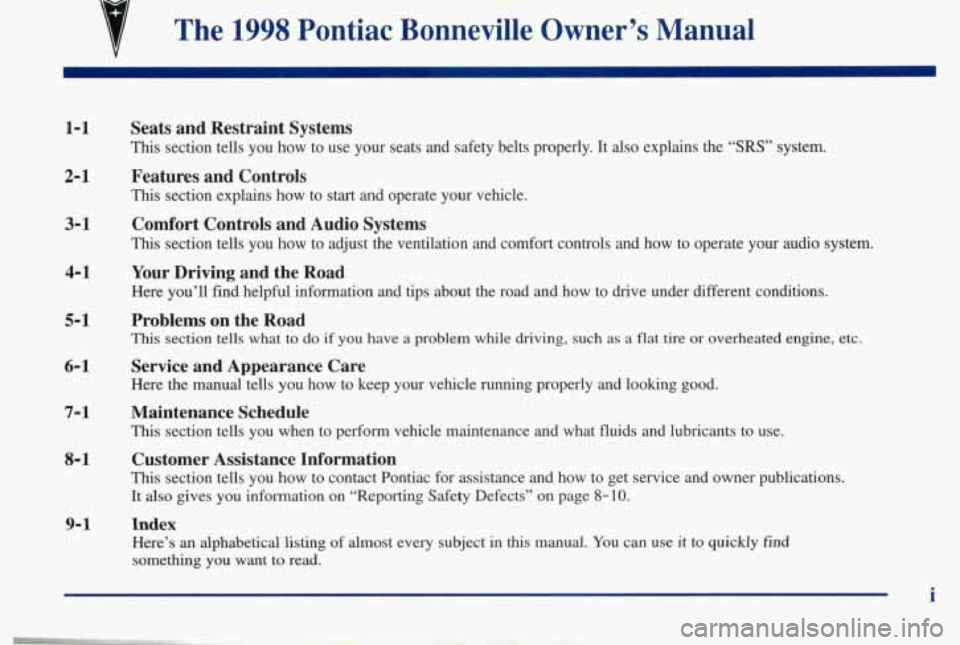
B
v
The 1998 Pontiac Bonneville Owner’s Manual
1-1
2-1
3-1
4-1
5- 1
6-1
7- 1
8- 1
Seats and Restraint Systems
This section tells you how to use your seats and safety belts prop\
erly. It also explains the “SRS” system.
Features and Controls
This section explains how to start and operate your vehicle.
Comfort Controls and Audio Systems
This section tells you how to adjust the ventilation and comfort co\
ntrols and how to operate your audio system.
Your Driving and the Road
Here you’ll find helpful information and tips about the road\
and how to drive under different conditions.
Problems on the Road
This section tells what to do if you have a problem while driving, such as a flat tire or overheated engine, etc.
Service and Appearance Care
Here the manual tells you how to keep your vehicle running properly and looking good.
Maintenance Schedule
This section tells you when to perform vehicle maintenance and what \
fluids and lubricants to use.
Customer Assistance Information
This section tells you how to contact Pontiac for assistance a\
nd how to get service and owner publications.
It also gives you information
on “Reporting Safety Defects” on page 8-10.
9-1 Index
Here’s an alphabetical listing of almost every subject in this manual. You can use it to quickly find
something you want
to read.
i
Page 3 of 395
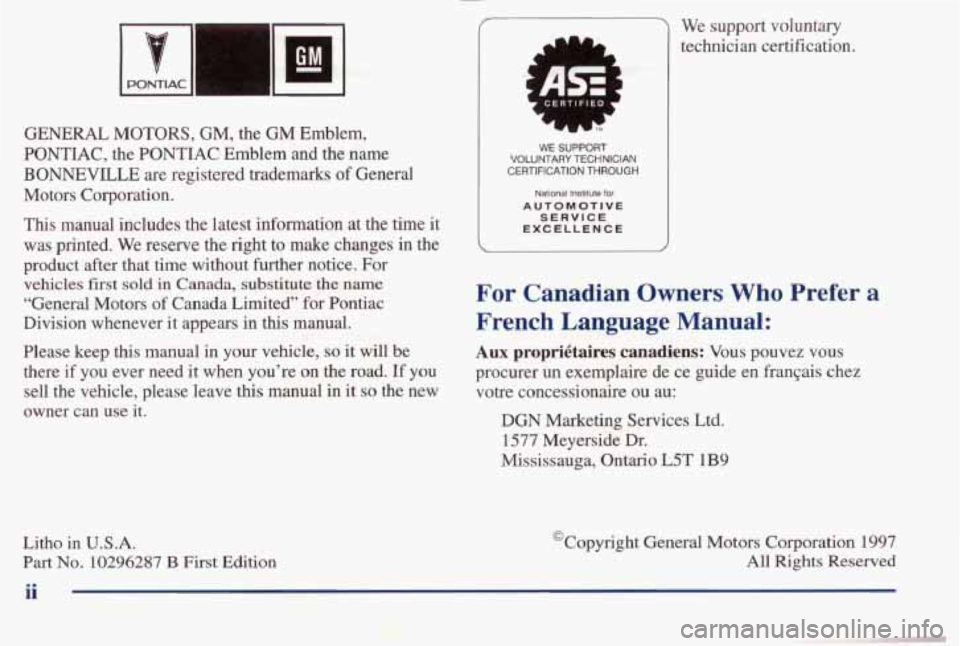
GENERAL MOTORS, GM, the GM Emblem,
PONTIAC, the PONTIAC Emblem and the name
BONNEVILLE are registered trademarks of General
Motors Corporation.
This manual includes the latest information at the time it
was printed. We reserve the right to make changes
in the
product after that time without further notice. For
vehicles first sold in Canada, substitute the name
“General Motors of Canada Limited” for Pontiac
Division whenever it appears in
this manual.
Please keep
this manual in your vehicle, so it will be
there
if you ever need it when you’re on the road. If you
sell the vehicle, please leave this manual in it so the new
owner can
use it.
Litho in U.S.A.
Part No, 10296287 B First Edition
WE SUPPORT VOLUNTARY TECHNICIAN CERTIFICATION THROUGH
National InstiMe for
AUTOMOTIVE SERVICE EXCELLENCE
We support voluntary
technician certification.
For Canadian 3wners Who Prefer a
French Language Manual:
Aux propri6taires canadiens: Vous pouvez vous
procurer un exemplaire de ce guide en fraqais chez
votre concessionaire ou au:
DGN Marketing Services Ltd.
1577 Meyerside Dr.
Mississauga, Ontario L5T 1B9
@Copyright General Motors Corporation 1997
All Rights Reserved
ii
Page 30 of 395
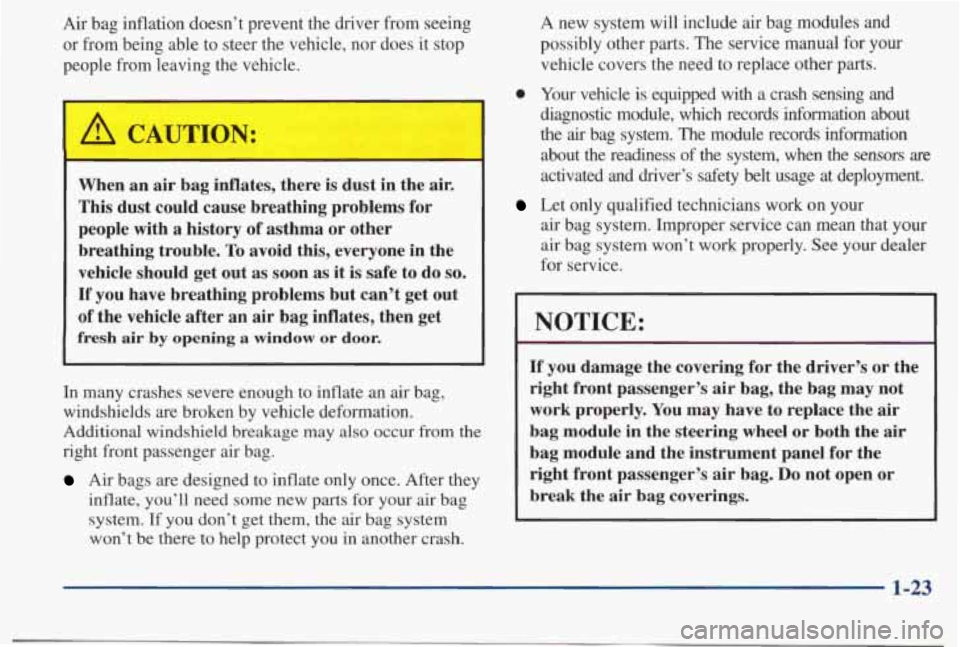
Air bag inflation doesn’t prevent the driver from seeing or from being able to steer
the vehicle, nor does it stop
people from leaving the vehicle.
A CAUTION:
When an air bag inflates, there is dust in the air.
This dust could cause breathing problems for
people with a history of asthma or other
breathing trouble.
To avoid this, everyone in the
vehicle should get out as soon
as it is safe to do so.
If you have breathing problems but can’t get out
of the vehicle after an air bag inflates, then get
fresh air by opening a window or door.
In many crashes severe enough to inflate an air bag,
windshields are broken by vehicle deformation.
Additional windshield breakage may also occur from the
right front passenger air bag.
Air bags are designed to inflate only once. After they inflate, you’ll need some new parts
for your air bag
system. If you don’t get them, the air bag system
won’t be there to help protect you in another crash.
A new system will include air bag modules and
possibly other parts. The service manual for your
vehicle covers the need to replace other parts.
0 Your vehicle is equipped with a crash sensing and
diagnostic module, which records information about
the
air bag system. The module records information
about the readiness of the system, when the sensors
are
activated and driver’s safety belt usage at deployment.
air bag system. Improper service can mean that your
air bag system won’t work properly. See your dealer
for service.
Let only qualified technicians work on your
NOTICE:
If you damage the covering for the driver’s or the
right front passenger’s air bag, the bag may not
work properly. You may have
to replace the air
bag module in the steering wheel or both the air
bag module and the instrument panel for the
right front passenger’s
air bag. Do not open or
break the
air bag coverings.
1-23
Page 31 of 395
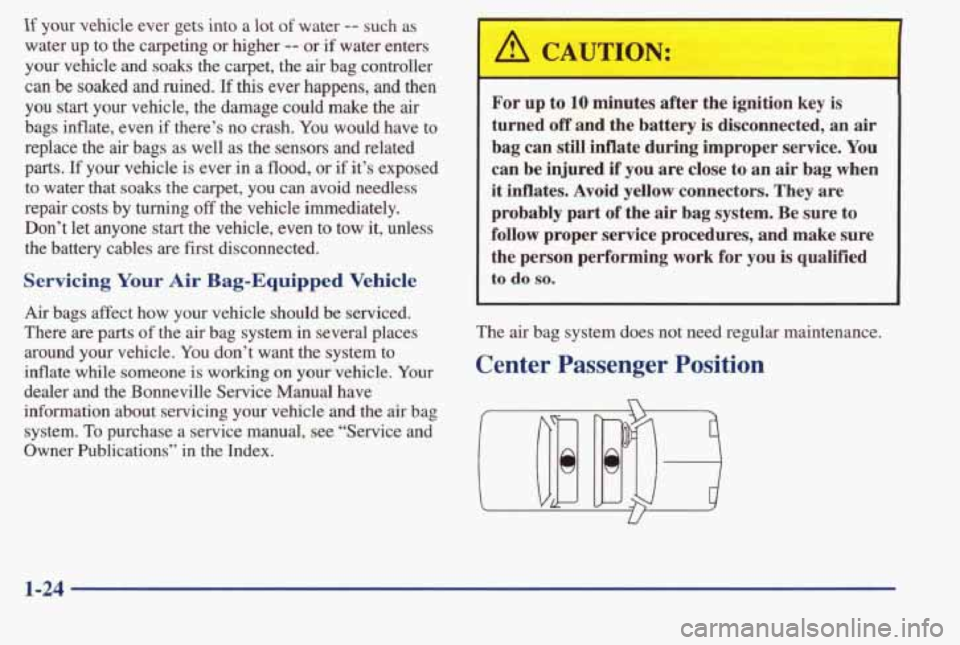
If your vehicle ever gets into a lot of water -- such as
water up to the carpeting or higher
-- or if water enters
your vehicle and soaks the carpet, the air bag controller
can be soaked and ruined. If this ever happens, and then
you
start your vehicle, the damage could make the air
bags inflate, even if there’s no crash. You would have to
replace the air bags
as well as the sensors and related
parts.
If your vehicle is ever in a flood, or if it’s exposed
to water that
soaks the carpet, you can avoid needless
repair costs by turning
off the vehicle immediately.
Don’t let anyone start the vehicle, even to tow it, unless
the battery cables are first disconnected.
Servicing Your Air Bag-Equipped Vehicle
Air bags affect how your vehicle should be serviced.
There are
parts of the air bag system in several places
around your vehicle. You don’t want the system to
inflate while someone
is working on your vehicle. Your
dealer and the Bonneville Service Manual have
information about servicing
your vehicle and the air bag
system.
To purchase a service manual, see “Service and
Owner Publications” in the Index.
I
For up to 10 minutes after the ignition key is
turned
off and the battery is disconnected, an air
bag can still inflate during improper service. You
can be injured
if you are close to an air bag when
it inflates. Avoid yellow connectors. They are
probably part
of the air bag system. Be sure to
follow proper service procedures, and make sure
the person performing work for you
is qualified
to do so.
The air bag system does not need regular maintenance.
Center Passenger Position
1-24
Page 67 of 395
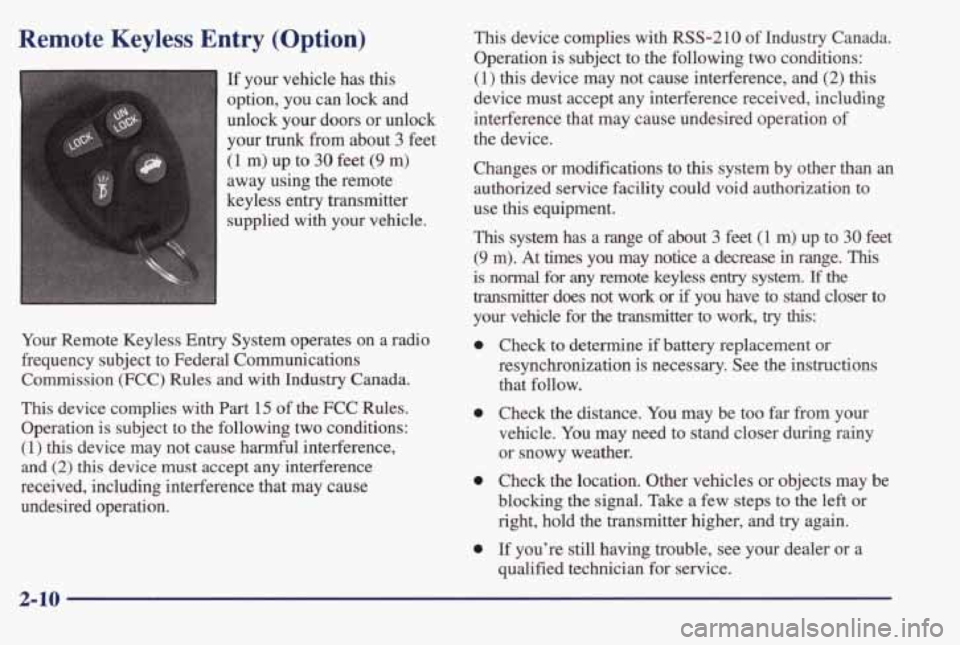
Remote Keyless Entry (Option)
If your vehicle has this
option, you can lock and
unlock your doors or unlock
your
trunk from about 3 feet
(1 m) up to 30 feet (9 m)
away using the remote
Your Remote Keyless Entry System operates
on a radio
frequency subject to Federal Communications
Commission (FCC) Rules and with Industry Canada.
This device complies with Part 15 of the FCC Rules.
Operation is subject to the following
two conditions:
(1) this device may not cause harmful interference,
and
(2) this device must accept any interference
received, including interference that may cause
undesired operation.
This device complies with RSS-210 of Industry Canada.
Operation is subject to
the following two conditions:
(1)
this device may not cause interference, and (2) this
device must accept any interference received, including
interference that may cause undesired operation of
the device.
Changes or modifications to this system by other than an
authorized service facility could void authorization to
use
this equipment.
This system has a range of about 3 feet (1 m) up to 30 feet
(9 m). At times you may notice a decrease in range. This
is normal for any remote keyless entry system. If the
transmitter
does not work or if you have to stand closer to
your vehicle for the transmitter to work, try this:
0
0
0
0
Check to determine if battery replacement or
resynchronization is necessary. See the instructions
that follow.
Check the distance.
You may be too far from your
vehicle. You may need to stand closer during rainy
or snowy weather.
Check the location. Other vehicles or objects may be
blocking the signal. Take
a few steps to the left or
right, hold the transmitter higher, and
try again.
If you’re still having trouble, see your dealer or a
qualified technician for service.
2-10
Page 74 of 395
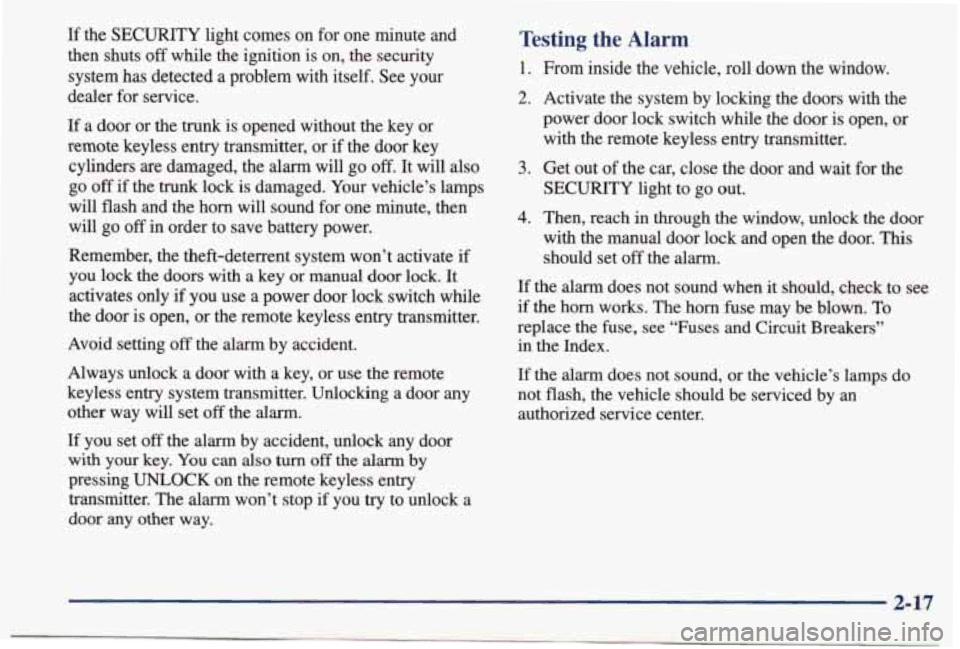
If the SECURITY light comes on for one minute and
then shuts
off while the ignition is on, the security
system has detected a problem with itself. See your
dealer for service.
If a door or the trunk is opened without the key or
remote keyless entry transmitter, or if the door key
cylinders are damaged, the alarm will go
off. It will also
go
off if the trunk lock is damaged. Your vehicle’s lamps
will flash and the horn will sound for one minute, then
will go off in order to save battery power.
Remember, the theft-deterrent system won’t activate
if
you lock the doors with a key or manual door lock. It
activates only
if you use a power door lock switch while
the door is open, or the remote keyless entry transmitter.
Avoid setting
off the alarm by accident.
Always unlock
a door with a key, or use the remote
keyless entry system transmitter. Unlocking
a door any
other way will set
off the alarm.
If you set off the alarm by accident, unlock any door
with your key. You can also turn off the alarm by
pressing UNLOCK on the remote keyless entry
transmitter. The alarm won’t stop if you
try to unlock a
door any other way.
Testing the Alarm
1. From inside the vehicle, roll down the window.
2. Activate the system by locking the doors with the
power door lock switch while the door is open, or
with the remote keyless
entry transmitter.
3. Get out of the car, close the door and wait for the
SECURITY light to
go out.
4. Then, reach in through the window, unlock the door
with the manual door lock and open the door.
This
should set off the alarm.
If the alarm does not sound when it should, check to see
if the horn works. The horn fuse may be blown.
To
replace the fuse, see “Fuses and Circuit Breakers”
in the Index.
If the alarm does not sound,
or the vehicle’s lamps do
not flash, the vehicle should be serviced by an authorized service center.
Page 75 of 395
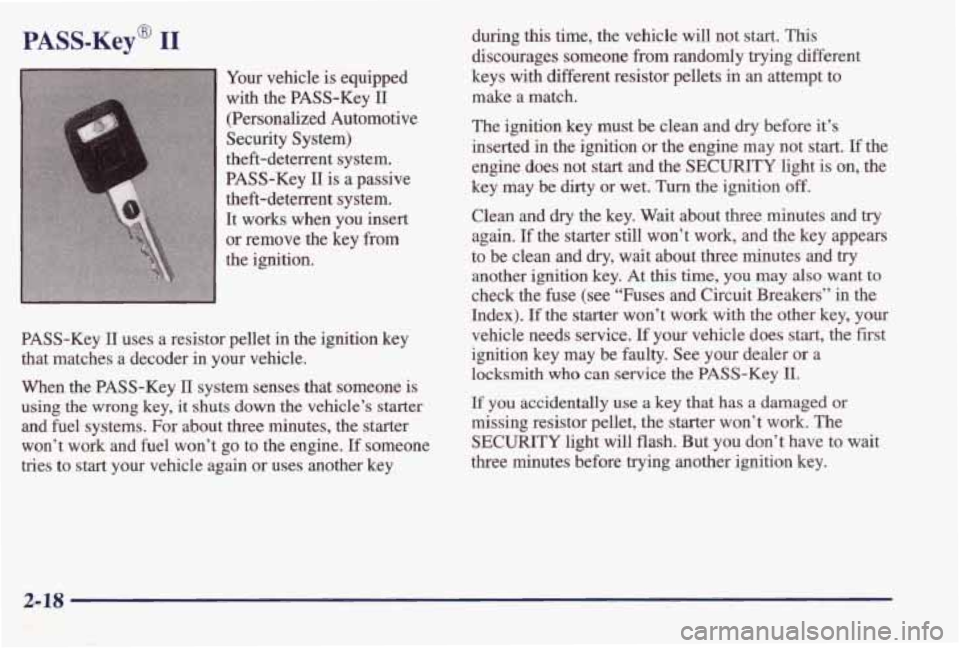
PASS-Key@ I1
Your vehicle is equipped
with the PASS-Key
11
(Personalized Automotive
Security System)
theft-deterrent system.
PASS-Key
II is a passive
theft-deterrent system.
It works when you insert
or remove the key from
the ignition.
PASS-Key
11 uses a resistor pellet in the ignition key
that matches a decoder in your vehicle.
When the PASS-Key
11 system senses that someone is
using
the wrong key, it shuts down the vehicle’s starter
and fuel systems. For about three minutes, the starter
won’t work and fuel won’t go to the engine.
If someone
tries
to start your vehicle again or uses another key during
this time, the vehicle will not start. This
discourages someone from randomly trying different
keys with different resistor pellets in
an attempt to
make a match.
The ignition key must be clean and
dry before it’s
inserted in the ignition or the engine may not start.
If the
engine does not
start and the SECURITY light is on, the
key may be
dirty or wet. Turn the ignition off,
Clean and dry the key. Wait about three minutes and try
again. If the starter still won’t work, and the key appears
to be clean and
dry, wait about three minutes and try
another ignition key. At this time, you may also want to
check the
fuse (see “Fuses and Circuit Breakers” in the
Index).
If the starter won’t work with the other key, your
vehicle needs service.
If your vehicle does start, the first
ignition key may be faulty. See your dealer
or a
locksmith who can service
the PASS-Key II.
If you accidentally use a key that has a damaged or
missing resistor pellet, the starter won’t work. The
SECURITY light will flash. But you don’t have to wait
three minutes before trying another ignition
key.
Page 76 of 395
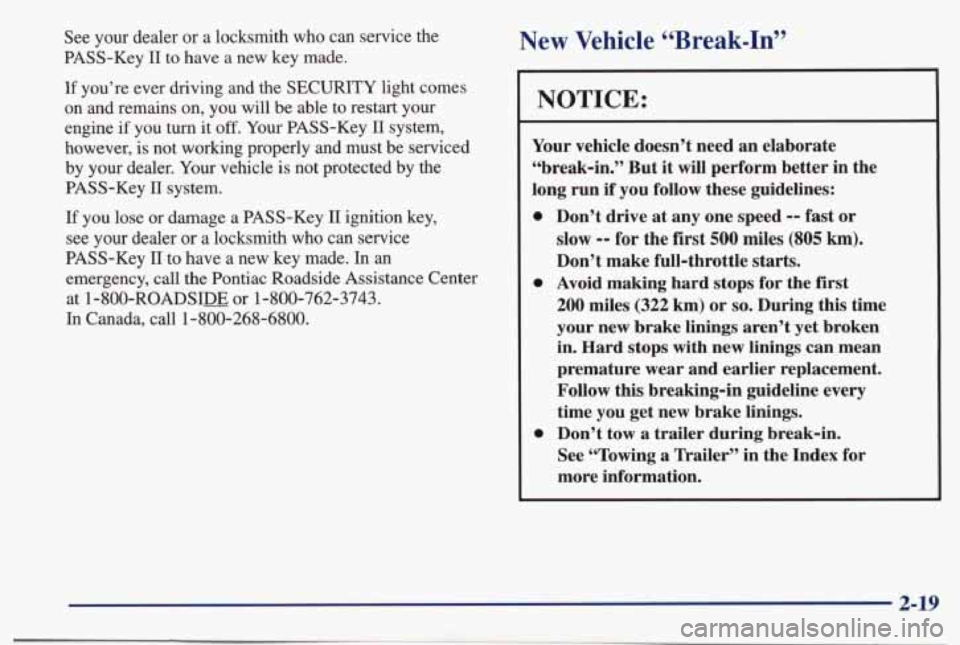
See your dealer or a locksmith who can service the
PASS-Key
I1 to have a new key made.
If you’re ever driving and the SECURITY light comes
on and remains on, you will be able to restart your
engine if you turn it off. Your PASS-Key
I1 system,
however, is not working properly and must be serviced by your dealer. Your vehicle is not protected by the
PASS-Key I1 system.
If you lose or damage a PASS-Key I1 ignition key,
see your dealer
or a locksmith who can service
PASS-Key
11 to have a new key made. In an
emergency, call the Pontiac Roadside Assistance Center
at
1 -800-ROADSIDJ or 1-800-762-3743.
In Canada, call 1-800-268-6800.
New Vehicle “Break-In”
NOTICE:
Your vehicle doesn’t need an elaborate
“break-in.” But it will perform better in the
long run
if you follow these guidelines:
0
0
0
Don’t drive at any one speed -- fast or
slow
-- for the first 500 miles (805 km).
Don’t make full-throttle starts.
Avoid making hard stops for the first
200 miles (322 km) or so. During this time
your new brake linings aren’t yet broken
in. Hard stops with new linings can mean
premature wear and earlier replacement.
Follow this breaking-in guideline every
time you get new brake linings.
Don’t tow a trailer during break-in.
See “Towing
a Trailer’’ in the Index for
more information.
2-19